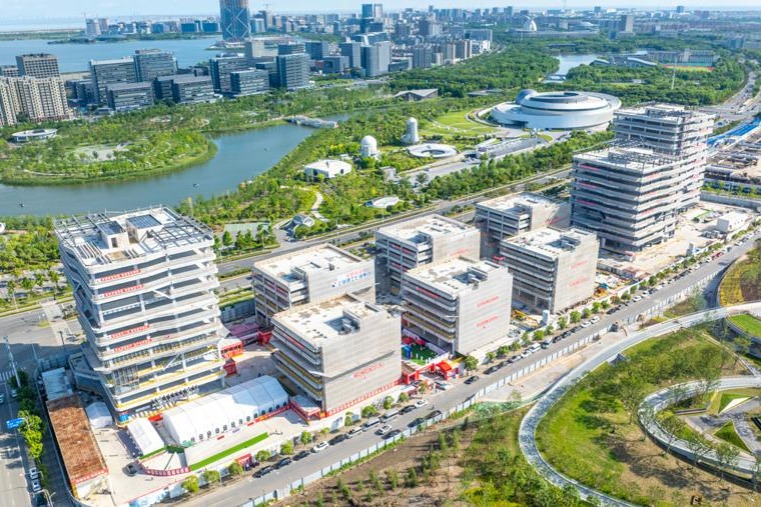On the up


With a package of government policies in place the economy is well-positioned to maintain its recovery in 2024
Editor's note: The world has undergone many changes and shocks in recent years. Enhanced dialogue between scholars from China and overseas is needed to build mutual understanding on many problems the world faces. For this purpose, the China Watch Institute of China Daily and the National Institute for Global Strategy, Chinese Academy of Social Sciences, jointly present this special column: The Global Strategy Dialogue, in which experts from China and abroad will offer insightful views, analysis and fresh perspectives on long-term strategic issues of global importance.
The world economy will continue its fight with the stagflation in 2024.
According to the International Monetary Fund's latest forecast, global growth is expected to slow to 2.9 percent, down from 3.0 percent this year, while the inflation rate is expected to drop from 6.9 percent to 5.8 percent.
China is expected to register GDP growth of about 5.3 percent this year. Its consumption is better than in 2022 but still worse than the pre-pandemic levels, and investment and exports remain lackluster. For the first three quarters, total retail sales of social consumer goods grew by 6.8 percent year-on-year, the growth in exports was 0.6 percent and the fixed-asset investment growth was 3.1 percent. Especially, real estate investment recorded a negative growth of 9.1 percent, a drag within the larger category. As for core price indicators, the consumer price index and producer price index grew at 0.4 percent and negative 3.1 percent respectively, revealing low aggregate demand.
Still, China's economy is likely to perform better in 2024. First, it has been on a steady, gradual rebound since it hit the trough in July. Total retail sales of social consumer goods turned positive for the first time in November after six months of negative growth. In the same period, the PPI rose from — 5.4 percent to — 3 percent. Notably, industrial added value by above-designated-size entities restored from 2.4 percent earlier this year to 4.3 percent in November.
The worst performing indicators in July were the total amount of new social financing and new renminbi loans, which were only 536.6 billion yuan ($75.2 billion) and 36.4 billion yuan respectively. They were also the lowest recorded in the past decade. By November, however, these two figures had rebounded to 2.45 trillion yuan and 1.11 trillion yuan. These short-term growth figures show that China's economy might well be on an upward curve and it will continue to recover in 2024.
Second, at the first Central Financial Work Conference, the Chinese government adopted a package of measures to address the potential financial risks stemming from local government debts and the real estate sector. Starting from October, some provinces have issued special refinancing bonds of nearly 1.5 trillion yuan, mainly to be used to repay the arrears owed by local governments. This will be under the supervision of provincial governments with the central government assuming an active supporting role. In terms of increment, however, the proportion of bonds issued by the central government and provincial governments will further outweigh those issued by governments in third- and fourth-tier cities. A new round of adjustment of financial and administrative powers of the central government and local governments is underway.
The most pressing risk in China's property market is the liquidity shortage faced by numerous private property developers. After the Central Financial Work Conference, the People's Bank of China, the State Administration of Financial Regulation, the China Securities Regulatory Commission and the Ministry of Housing and Urban-Rural Development jointly held a meeting to discuss ways to alleviate the liquidity shortage of many leading high-quality private enterprises. For now, the probability of collective debt default in the short term is low. In the long term, however, a new model of real estate development is needed in addition to commercial housing to resolve the grave risks in the market.
Third, the 2023 Central Economic Work Conference signaled that the Chinese government will step up its efforts to stabilize growth, which will provide policy and institutional guarantees for China's economic growth in 2024. The general principle of "promoting stability through progress" means that a moderate and rapid growth is still a key note in China's economic policy. Based on this, it is believed that China's economic growth target for 2024 will be around 5 percent. Besides, the conference also stressed grasping the relationship between the new economy (for example the digital economy and the green economy) and the old economy (for example real estate and traditional infrastructure). Given the existing gap between their respective sizes, it is crucial to ensure the steady development of the traditional sectors until the new drivers of development are fully felt.
Besides, expansionary fiscal policy must intervene when the expectations and confidence of micro actors are still low. In October, the central government announced an additional 1 trillion yuan of government bonds for post-disaster reconstruction, half of which will be used this year and the other half in 2024.This move shows a more positive fiscal policy in 2024. Combined with the above-mentioned equivalent amount of national bonds, the actual ratio of central fiscal deficit to GDP in 2024 may exceed 4.0 percent, proof of a looser fiscal policy in 2024.
To sum up, China's macroeconomic growth is in the process of self-recovery and on the right track toward 2024. The government's package of policies to prevent and resolve systemic financial risks have signaled increased efforts to stabilize growth and promote development. The good news is that the microeconomic players such as households and small-sized enterprises may feel the benefits. China's GDP growth has the potential to reach 5.0 percent and its CPI growth is expected to be 2 percent in 2024.
The author is deputy director of the Institute of Finance and Banking at the Chinese Academy of Social Sciences and deputy director of the National Institution for Finance and Development. The author contributed this article to China Watch, a think tank powered by China Daily. The views do not necessarily reflect those of China Daily.
Contact the editor at editor@chinawatch.cn


































